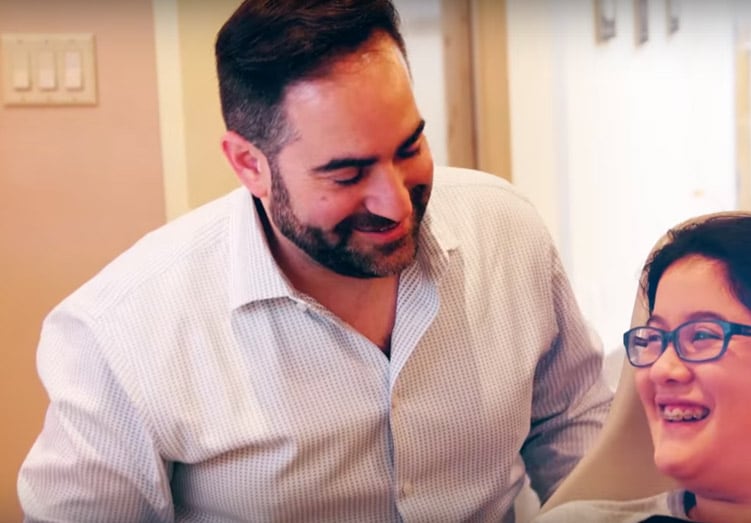Many kids and adults need braces and are referred to a specialist called an orthodontist. In fact, over four million people in the United States wear them each year. These appliances can help to straighten crooked teeth or fix a misaligned jaw. It is helpful to know what to expect at each appointment. Knowledge helps to alleviate any fears you may have about the process and procedures. In this post, we’ll show you what an orthodontist first time is like. Let’s crack on.
People also ask
- What do they do on your first visit to the orthodontist?
- What does the orthodontist do?
- Do you need a referral to see an orthodontist?
- Do orthodontists charge for consultations?
What Are Braces?
First, it is important to know what you will be wearing in your mouth. There are several different types of appliances that can be used to help correct a variety of problems you may have. The traditional metal brackets that kids have worn for decades are still in use today. The metal brackets are affixed to the teeth and a wire is woven through them to push and pull teeth into the correct positions. Sometimes, bands are also used in this process. Some practices offer a variety of colors for the brackets while others stick with the traditional metal braces.
Another type of orthodontic appliance that is commonly an option is Invisalign. These clear, plastic devices fit over the teeth and are barely visible to others. A sequence of custom-made aligners is used to gradually shift the teeth into their proper places.
In addition, there are other appliances that can also be used to assure that the teeth and jaw are properly corrected. Depending on your situation, you may need to wear a palatal expander, spacers, holding arches, or retainers. Only a qualified orthodontic specialist will know exactly the right treatment for you.
Orthodontist First Time
Many orthodontist first time visits offer a free consultation before beginning any work. This is a great time to get advice and ask questions about your specific situation. Since you will be spending a fair amount of time and money with this doctor and staff, it is a good idea to shop around to find the right professionals for you or your children.
Typically, the first time you see an orthodontist at an appointment, a full oral exam will be required to determine the needs of the patient. This will likely include X-rays of the teeth and mouth, and it may include taking digital impressions of the teeth. Once the doctor has completed the exam, they will likely sit down and explain the situation and recommended treatment.
This is a good time to ask questions and get all of the information you need. It is also a good time to talk to the doctor about the practice, their philosophies, and other matters that will help you determine if this is the orthodontic expert for you. Once you completely understand the procedures, you will often get to speak to a member of the orthodontic team about costs.
Cost
The cost of treatment varies greatly among regions. Additionally, the type of orthodontic work, the amount of time you will need to spend in treatment, and other factors may play a part in the total costs incurred with the straightening of the teeth. A member of the team can discuss the obligations as well as what your insurance will cover, and payment plans when necessary. You should get this information in writing in case you want to compare it to other offices.
In addition, you may get a tour of the office, meet and speak to other staff members, and/or see short videos on the treatments you will be receiving. All of these activities are intended to make you and your child feel more comfortable in the office and with the staff who will be working in your mouth. Also, the entire first visit can take some time, anywhere from 30 minutes to two hours, deepening on the amount of detail and how busy the office is.
Having Braces put on
The installation of these dental appliances can take an hour or two. Making sure that the brackets are properly placed is essential for proper care. There are several steps that your provider will take to ensure that you will have a successful outcome:
- First, the teeth may be cleaned with a special cleaner so that the glue will bond properly to the braces.
- Next, your teeth will be rinsed and thoroughly dried with puffs of air. To keep them completely dry, a bite block may be put in your mouth to keep you from touching the teeth with your tongue.
- Special bonding substances will be applied to the surfaces of your teeth. The brackets will be placed in the right spot on each tooth. Excess “glue” will be wiped away.
- Once all of the brackets are placed on the teeth and the glue has dried, the wires will be attached. Ends may need to be clipped so that they do not rub your mouth or gums.
- If you have the need, elastic bands may also be placed in strategic locations on the brackets. If this is being done, you will likely get to choose the colors of the bands.
Will it Hurt?
With metal braces, getting the brackets and wires placed may be uncomfortable but should not be painful. Let your orthodontist know if you experience pain, and there is likely something they can do to help ease it. Nonetheless, it is likely that your teeth will feel sore for a short time after having the appliance placed. There are some things that you can do to alleviate some of the discomforts:
- Eat soft foods until you can tolerate more. Good choices can include smoothies, soups, mashed potatoes, yogurt, and soft pasta.
- Take over-the-counter pain medications such as acetaminophen or Ibuprofen. Read the labels and only take them as directed.
- Use dental wax to cover parts of the appliance that may rub on your mouth. This will help it not rub directly.
- Keep your mouth clean, especially if you have mouth sores. Swishing with salt water or other commercial products can sometimes be useful.
How Will I Care for my Teeth?
While wearing dental appliances, it is especially important to pay extra close attention to teeth hygiene.
You should brush your teeth after every meal, taking extra care to assure that food is not stuck in the wires or brackets. You should also floss once per day to remove food that gets lodged between teeth. There are special flossers that help get around the wires and between the teeth.
In addition, when caring for your teeth during treatment, you will likely need to avoid some foods. Any foods that are especially hard, such as nuts and hard candies or sticky are usually on the banned list. These types of foods can break brackets or snap wires, making you potentially uncomfortable and treatment stagnant. In addition, foods that you have to bite into, such as burgers, corn on the cob, or a whole apple will likely cause damage that you will want to avoid. Cut these foods into smaller pieces before eating.

See an Orthodontist Today
Once appliances are placed and orthodontic treatment begins, patients can expect seeing an orthodontist about every six to eight weeks. These visits will allow the doctor and staff to assess the progress of their work. Moreover, they will be able to tighten wires over teeth, replace bands, and fix any issues that may arise. These orthodontist first time appointments typically last about 30 minutes or less.
Conclusion
In the end, you will have straight teeth that you can be proud of. Your mouth will be in the best shape, healthier and your smile brighter. For expert care, see an orthodontist like contact Dr. Schulhof’s Center for Orthodontics today for your initial consultation on a treatment plan. Your orthodontist first time is an easy time with us.
- Which tip will you try first???
- Either way, let us know by leaving a comment below right now and continue the conversation.
The Schulhof Center for Orthodontics
400 Kinderkamack Rd.
Oradell, NJ 07649
P: 551-231-5323
Orthodontist First Time | WHAT TO EXPECT IN 2020 | FAST FACTS




